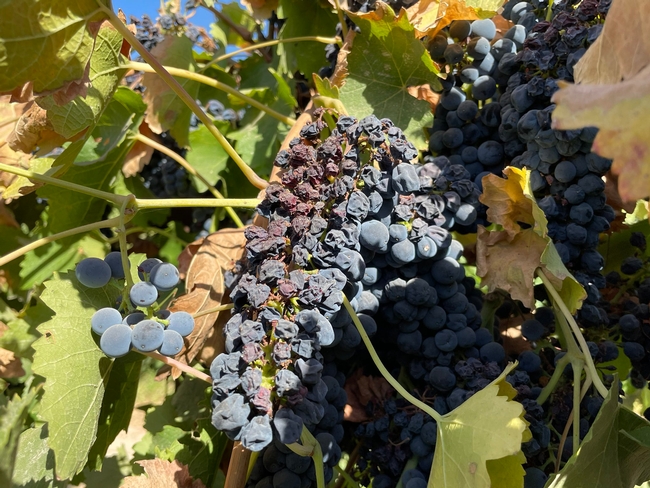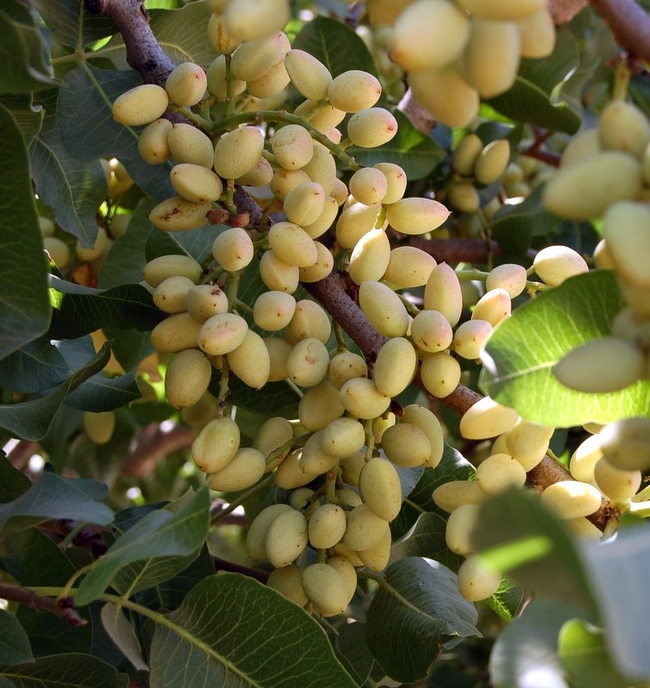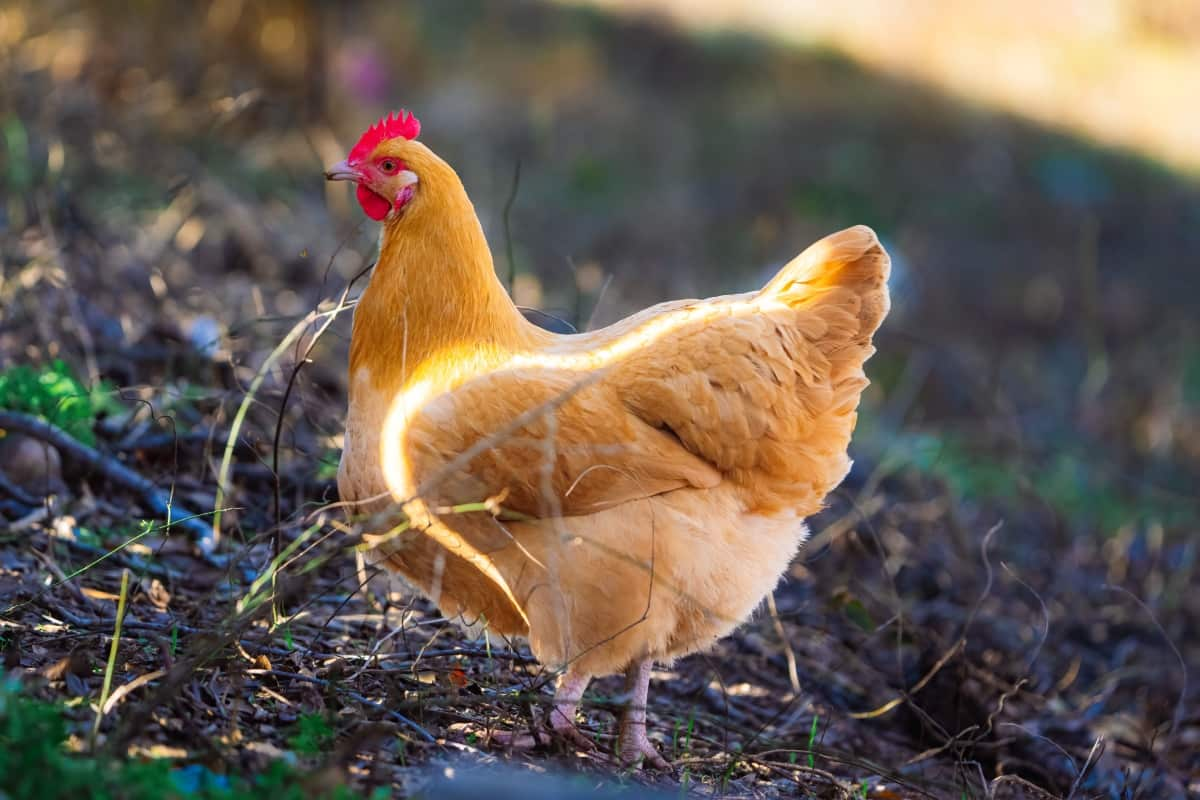Added key climate data to improve grower decision support tool
With advance notice from CalAgroClimate, farmers may be able to use heaters, wind turbines, irrigation and other tactics to mitigate some of the impacts of cold weather, such as almond blossom damage. . Photo by Will Suckow
Free CalAgroClimate tool helps growers protect crops from frost and extreme heatCalifornia farmers can see how climate conditions that can affect agriculture are changing in their regions by using CalAgroClimate so they can make strategic changes. Nine new climate indicators important to agriculture have been added to the decision support tool created by scientists at UC Cooperative Extension and the United States Department of Agriculture.
These new tools use a high-resolution climate dataset called PRISM to provide location-specific or county-aggregated long-term trends in agroclimate indicators from 1980 to the last year. These new agroclimatic indicators include frost days, last spring frost, first fall frost, frost-free season, tropical nights, hot days, extreme heat days, heat waves, and daytime temperature range ( see definitions below). These indicators come from a study published in the journal Agronomy.
All new tools are free and available on CalAgroClimate for everyone to access.

Viticulturists may be able to protect grapes from extreme heat. Photo by George Zhuang
"Freeze-related tools such as Frost Days, Last Spring Freeze, First Fall Freeze, and Freeze-Free Season can help farmers and farm customers make informed, long-term choices," said Tapan B. Pathak , a cooperative extension specialist at UC. in Climate Adaptation in Agriculture based at UC Merced, which leads the CalAgroClimate project.
"For example, if you are considering investing in a frost-sensitive crop in your area, these indicators can provide valuable information on whether the risk of frost has changed over time and is less risky to make such an investment," he said. said. “Wine grapes, for example, are very sensitive to frost. Although not all frost events are damaging, understanding long-term frost trends can help make long-term strategic decisions, such as investing in frost protection."
Another set of new agroclimate indicators, on CalAgroClimate - Tropical Nights, Hot Days, Extreme Heat Days, Heat Waves and Daytime Temperature Range - are based on higher maximum and minimum temperatures. Tropical Nights, for example, calculates the total number of nights when nighttime temperatures exceed 68 F. More frequent tropical nights can increase crop respiration rates and can adversely affect fruit quality and quantity, increase the risk of pathogen damage and potentially impact fruit set. and performance.
Knowing how trends change over time can help growers manage their crops to reduce risk. Likewise, growers can easily view heat-related trends — hot days, extreme heat, and heat waves — on CalAgroClimate to gauge their options on what they need to do to adapt. In the short term, growers can shade or, in the longer term, choose more heat-tolerant varieties.

Pistachios need a number of hours of chilling, but heat units to bloom.
"In a recently published work, one of the Central Valley farmers told us, "When you really see so much difference in a short time in your immediate area...we should look at that and say, hey well, we're going to have to adapt the varieties because it's a 20 or 25-year-old plantation and we're going to have to find crops or varieties that will adapt to that,” Pathak said.
Another farmer told us, "Knowing what's going to happen or at least having a good idea, if you know something is going to be or isn't going to be viable, then obviously you're going to try to phase it out, and set up something more suitable."
Pathak added, "The new agroclimate indicators on CalAgroClimate provide a reality check...


With advance notice from CalAgroClimate, farmers may be able to use heaters, wind turbines, irrigation and other tactics to mitigate some of the impacts of cold weather, such as almond blossom damage. . Photo by Will Suckow
Free CalAgroClimate tool helps growers protect crops from frost and extreme heatCalifornia farmers can see how climate conditions that can affect agriculture are changing in their regions by using CalAgroClimate so they can make strategic changes. Nine new climate indicators important to agriculture have been added to the decision support tool created by scientists at UC Cooperative Extension and the United States Department of Agriculture.
These new tools use a high-resolution climate dataset called PRISM to provide location-specific or county-aggregated long-term trends in agroclimate indicators from 1980 to the last year. These new agroclimatic indicators include frost days, last spring frost, first fall frost, frost-free season, tropical nights, hot days, extreme heat days, heat waves, and daytime temperature range ( see definitions below). These indicators come from a study published in the journal Agronomy.
All new tools are free and available on CalAgroClimate for everyone to access.

Viticulturists may be able to protect grapes from extreme heat. Photo by George Zhuang
"Freeze-related tools such as Frost Days, Last Spring Freeze, First Fall Freeze, and Freeze-Free Season can help farmers and farm customers make informed, long-term choices," said Tapan B. Pathak , a cooperative extension specialist at UC. in Climate Adaptation in Agriculture based at UC Merced, which leads the CalAgroClimate project.
"For example, if you are considering investing in a frost-sensitive crop in your area, these indicators can provide valuable information on whether the risk of frost has changed over time and is less risky to make such an investment," he said. said. “Wine grapes, for example, are very sensitive to frost. Although not all frost events are damaging, understanding long-term frost trends can help make long-term strategic decisions, such as investing in frost protection."
Another set of new agroclimate indicators, on CalAgroClimate - Tropical Nights, Hot Days, Extreme Heat Days, Heat Waves and Daytime Temperature Range - are based on higher maximum and minimum temperatures. Tropical Nights, for example, calculates the total number of nights when nighttime temperatures exceed 68 F. More frequent tropical nights can increase crop respiration rates and can adversely affect fruit quality and quantity, increase the risk of pathogen damage and potentially impact fruit set. and performance.
Knowing how trends change over time can help growers manage their crops to reduce risk. Likewise, growers can easily view heat-related trends — hot days, extreme heat, and heat waves — on CalAgroClimate to gauge their options on what they need to do to adapt. In the short term, growers can shade or, in the longer term, choose more heat-tolerant varieties.

Pistachios need a number of hours of chilling, but heat units to bloom.
"In a recently published work, one of the Central Valley farmers told us, "When you really see so much difference in a short time in your immediate area...we should look at that and say, hey well, we're going to have to adapt the varieties because it's a 20 or 25-year-old plantation and we're going to have to find crops or varieties that will adapt to that,” Pathak said.
Another farmer told us, "Knowing what's going to happen or at least having a good idea, if you know something is going to be or isn't going to be viable, then obviously you're going to try to phase it out, and set up something more suitable."
Pathak added, "The new agroclimate indicators on CalAgroClimate provide a reality check...
What's Your Reaction?














![Three of ID's top PR executives quit ad firm Powerhouse [EXCLUSIVE]](https://variety.com/wp-content/uploads/2023/02/ID-PR-Logo.jpg?#)







